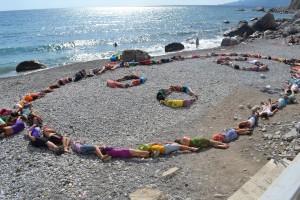or, Thinking about Long-term Research in the Context of Change
This post is republished from Canonball, a feminist blog I contributed to a few years ago. It is reproduced here for some background about my theoretical framework for this research, particularly why I see gender issues as so central to my project. This post has been edited slightly from its original appearance.
Last time, I wrote about state socialism, its fall, and the relevance of feminism for post-Soviet women. I’d like to use that as a frame through which to discuss various manifestations of women’s activism in the former Communist world. This time, I’ll focus on Russia and Ukraine. Two women have been studying the work of the emergence of the “third sector” in these countries after the fall of the Soviet Union (both became independent in 1991). Julie Hemment’s 2007 Empowering Women in Russia and Sarah Phillips’ Women’s Social Activism in the New Ukraine (2008) deal with similar themes, including the professionalization of the NGO world and the relevance of “civil society” to women’s and feminist activism. I’ll touch on each of these in turn and conclude with some concerns provoked by Phillips’ work and some food for thought about long-term anthropology in volatile places.
As the authors explain, the third sector is part of a triad made up of the state, the private sector, and what Hemment calls “citizens’ initiatives” (48). Since the fall of state socialism, that third sector has had to take up the slack of the ruined social welfare programs in former Communist countries. That is, groups like NGOs now play the role of taking care of people’s needs that go unmet by the government. And, in both Russia and Ukraine, women have had more difficulty in the capitalist job market, pushing them to work in the third sector.
For Phillips, this represents a shift in gender attitudes in Ukraine. Following failed Soviet efforts to equalize genders through wage work, post-socialist Ukraine has harkened back to motherhood and the goddess-like qualities of women in their redefinition of gender roles (check out pagan stories of Berehynia for more detail). So, because the woman-mother-goddess of the “New Ukraine” is nurturing, caring, and loving, she is in a prime place to participate in the third sector’s social welfare role. Further, her interest in women’s and family issues is of special concern for Western foundations that are highly inclined to send money to social welfare organizations that promote “democratizing” efforts. In other words, Western foundations are interested in projects that focus on individual empowerment and bettering oneself — the tenets of democracy — rather than on collective aid and solidarity building, which are construed as “Communist” or “Soviet.”
However, these groups aren’t so far from their Soviet pasts. Hemment suggests that NGOs in Russia aren’t about empowering the grassroots and challenging post-socialist hierarchies. Instead, “the third sector provides a structural and symbolic framework for the reproduction of former elites of the Soviet regime” (48) — a new class is created, but in the same image and from the same pool as the party elite that controlled the Soviet state. Among the women Phillips studied in Ukraine, the only one who succeeded (materially, anyway) was a woman who entered the business world through her ties among NGO workers. So, NGOs work to produce a sort of business-class elite, largely the same people as the Soviet party-state elite, that is integral to the development of a market economy. And ultimately, a market economy the best signifier of successful transition away from Communism.
What does all this say about feminism in the post-Soviet world? This is where the concept of civil society comes to play. As Hemment describes, civil society began to play an important role in Soviet states in the 1980s. In particular, civil society was seen as the place to challenge and resist Soviet rule. Hemment describes this “anti-politics” movement as “an oppositional stance that opposed the socialist state by addressing the individual” (49). While conceived of as an alternative space between communism and capitalism, civil society and action within it was interpreted in the West as a desire to join world capitalism. The promotion of civil society began to be construed as part of the rejection of state socialism and the transition to democracy and free market economics.
As both authors describe, this co-optation of the civil society idea led to a conflation of the third sector and civil society. Now, NGOs are meant to represent all the potential of civil society and the triumph of capitalism in formerly Communist places. Furthermore, the segments of the triad of state, private, and third sectors are not disengaged from one another but intimately linked, meaning that the third sector is not independent from the central government at all. In this way, free-market reforms have redefined civil society in a very narrow way.
This brings me to Hemment’s idea of “gender mainstreaming.” Many international NGOs are interested in women’s issues, and they are very much inclined to expand their work into places like Russia and Ukraine. But these organizations often have a very particular idea of what women should be concerned about, and, like I described last month, these aren’t necessarily the real concerns of post-Soviet women. Whereas civil society has the potential to be a space in which feminists of all forms can speak out, it is instead representative of what Chandra Mohanty has called “free-market feminism” (cited by Hemment, pg. 3). Women’s advancement is measured by their successes in business, and “gender” becomes a catchphrase employed by Russian activist groups wishing to secure funds. Civil society feminism, in which all people could actively reject the roles imposed on them by the state, now only exists in the hearts and minds of the most dedicated activists.
This is a sad, disheartening tale for those of us who believe in a better world. These authors recognize this problem, and so they caution us against fully rejecting the work of the third sector. Hemment is particularly apt in reminding us about the limitations of critiques of NGOs. Most important is the importance she places on agency — we still make decisions and take action for ourselves, and we should still have faith in our ability to use those decisions and actions to make change. If we’re too critical of NGOs and the reach of global capitalism, we ignore the agency of the women participating in these organizations, particularly at the local level. Sure, they shouldn’t have to bend to the whims of international funding agencies. But are they making differences in the lives of women at home? Perhaps, ultimately, this is the more pressing question, and the more pertinent for the development of global feminism.
Sarah Phillips’ book produces some thoughts about the nature of doing ethnography in places where change is the order of the day. When I first read her book, I felt that it was incomplete. The bulk of Phillips’ work in Ukraine was completed by 2003. As you may know, in 2004, the country had a revolution. The elections of that year, between Russian-backed Viktor Yanukovich and Western-oriented Viktor Yushchenko, were rigged in Yanukovich’s favor (you may also remember that Yanukovich’s team attempt to assassinate Yushchenko with dioxin poison). All over Ukraine, citizens poured into the streets and demanded a fair recount — their Orange Revolution. What they got instead was several rounds of new elections and ultimately victory for Yushchenko. But Yushchenko proved to be a pushover, trying to appease both the West and Russia, and eventually his parliament — headed by Yulia Tymoshenko, pretty much the only female figure in Ukrainian politics — was disbanded, and a coalition with Yanukovich formed. To make a long story short, over the next few years, Yushchenko failed to come through, Yanukovich is now in power, and Tymoshenko is now in jail.
Phillips returned for follow-up fieldwork in 2005 and 2006, but unfortunately the majority of her work from before the Orange Revolution had lost some of its potency. This doesn’t mean her work was bad, it simply meant that things changed for Ukraine so drastically during and following the revolution that the social problems that seemed so important in 1998 and 1999 could not possibly have the same relevance now. If feminist research is about understanding how women think about their real worlds, then this book mainly illustrates a past world. Ukrainian civil society now is completely different — in a lot of ways, people have lost faith in political participation. And the only woman who has any power, Tymoshenko, is a gas oligarch who made her money through free-market capitalism after the Soviet Union fell.
Phillips’ book highlights a tremendous conundrum of academic research — it takes so long to complete, it’s always a risk to invest so much in one project. Because of the drastic shifts in 2004 and increasing instability following the Orange Revolution, the problems Phillips highlights have gotten more severe. Both Phillips’ and Hemment’s more recent work (on disability and government-backed youth organizations, respectively) highlights the ways current governments are outsourcing social welfare to external groups. This means that health care, elder care, access to work and to mobility for those with disabilities, and political education is being designated as the responsibility of young people and women, who are already at disadvantages in the job market. Despite the challenges faced by Phillips because of political changes in Ukraine, we can clearly see the path of disadvantage and disenfranchisement through Women’s Social Activism to her newer — and to me, more enriching — research on disability, mobility, and citizenship in Ukraine.
Talking about women and gender in the postsocialist context seems to change daily. From constant new revelations about Femen to the excessive punishment of three members of the punk collective Pussy Riot, the conversation about feminism in Russia and Ukraine is clearly ongoing. While academic research is certainly not the the only way to think about this conversation, researchers like Julie Hemment and Sarah Phillips remind us to consider the lengthy history of feminism in this context and the effects political and social changes have on women and gender politics in postsocialism.



